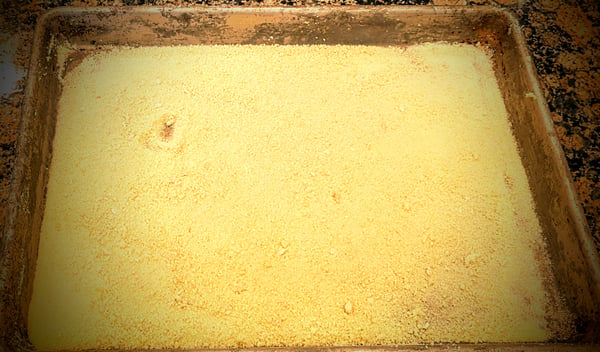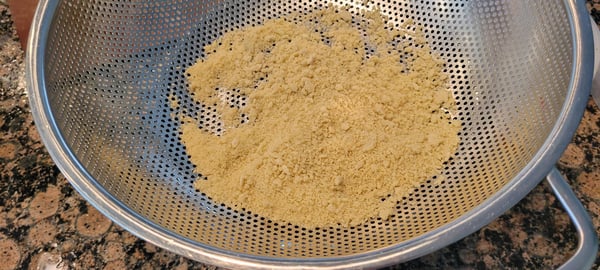I was preparing a curry with a Moroccan leaning. Everyone’s Favorite Grocery Store had no couscous (?) except for pearled/Israeli couscous of which it had two kinds (?). I wanted fine couscous, so of course I thought. “I’ll just make my own!”
But Everyone’s Favorite Grocery Store had no semolina flour either. I went to procure some elsewhere.
Semolina is the coarsely ground meal from durum wheat, the hard wheat grown greatly in the Middle East. Couscous is, essentially, pasta. (There is no grain called couscous!) It is made from semolina flour and water. Salt can be added. The trick is to add the water to the semolina gently enough so that each grain is individually moistened to swell without creating a big clump of dough with its neighbors. If this happens, those clumps can be pressed through a sieve to break apart, but that turns a gentle process into an exercise in exertion.
The gentle process, this day in age, has found great value in the spray bottle. Essentially, the grains will cluster in whatever size droplets of water introduced to it. So lets minimize the droplet size! I spread my semolina, one third cup at a time, out on a sheet pan. With more experience, you can work with more semolina at a time. Make sure that sheet pan is very clean! The water, combined with the grit of the grain, will exfoliate your prized, baked-on, seasoned pans (speaking from personal experience).


Vegetable Curry
Scroll down for a printable version of this recipe
Serves: 8
Prep time: 30 minutes
Cook time: 30 minutes
Total time: 1 hour
2 cups grape tomatoes, halved
1/4 cup extra virgin olive oil
1 onion, large dice
1 cup carrot, large dice
3 cloves garlic, rough chopped
1 1/2 teaspoon cinnamon
1 teaspoon paprika, 1/2 teaspoon coriander
1 1/2 teaspoon cumin
3/4 teaspoon ground ginger
1 teaspoon turmeric
1 Tablespoon tomato paste
6 cups vegetable stock
1 lemon’s peel
Salt
1 large Yukon potato, large dice
1/2 large sweet potato, large dice
1/2 head cauliflower, 1-inch florets
1/2 pound tofu, large dice
1 x 15 oz can chickpeas, rinsed
1/4 cup raisins
Lemon juice
Cous cous, homemade or store-bought
3. Add garlic and spices and cook for a minute.
4. Add tomato paste, then stock.
5. Simmer for 5 minutes to season stock.
6. Add potatoes and cauliflower. Simmer for 15 minutes until tender.
7. Add tofu, chickpeas and raisins and simmer for a final five minutes.
I check my seasoning along the way and add small increments of salt to build toward the final seasoning. It’s difficult to make large salt adjustments all at once! You should increase the other spices along the way as you see fit. Many more lessons on flavor building are incorporated into our Essential Building Blocks class, as well as Knife Skills for all of the dicing!
Vegetable Curry
Ingredients
- 2 cups grape tomatoes, halved
- 1/4 cup extra virgin olive oil
- 1 onion, large dice
- 1 cup carrot, large dice
- 3 cloves garlic, rough chopped
- 1 1/2 teaspoon cinnamon
- 1 teaspoon paprika, 1/2 teaspoon coriander
- 1 1/2 teaspoon cumin
- 3/4 teaspoon ground ginger
- 1 teaspoon turmeric
- 1 Tablespoon tomato paste
- 6 cups vegetable stock
- 1 lemon’s peel
- Salt
- 1 large Yukon potato, large dice
- 1/2 large sweet potato, large dice
- 1/2 head cauliflower, 1-inch florets
- 1/2 pound tofu, large dice
- 1 x 15 oz can chickpeas, rinsed
- 1/4 cup raisins
- Lemon juice
- Cous cous, homemade or store-bought
Instructions
- Spread the grape tomatoes on a parchment-lined toaster oven tray and roast at 250 degrees to dry them out.
- In a large pot, heat oil and sauté onions and carrots until softened slightly.
- Add garlic and spices and cook for a minute.
- Add tomato paste, then stock.
- Simmer for 5 minutes to season stock.
- Add potatoes and cauliflower. Simmer for 15 minutes until tender.
- Add tofu, chickpeas and raisins and simmer for a final five minutes.
- Finish seasoning with salt and lemon juice. Serve with cous cous.
